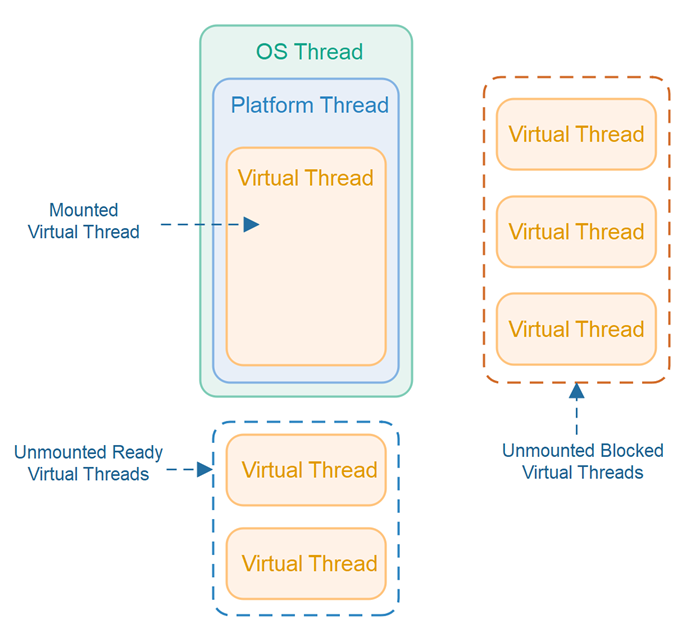The Future of Java Performance: How Project Loom is Reshaping Concurrency
For decades, Java developers have grappled with the complexities of concurrent programming. The traditional thread-per-request model, while simple to understand, has long been a bottleneck for building high-throughput, scalable applications. Each platform thread maps directly to a heavy operating system thread, making them a scarce and expensive resource. This limitation forced the ecosystem to develop complex, asynchronous, and often hard-to-debug solutions like reactive programming. The latest Java news, however, signals a monumental shift. Enter Project Loom, an ambitious OpenJDK initiative that fundamentally rethinks concurrency on the JVM. Finalized in Java 21 news, Project Loom introduces virtual threads, structured concurrency, and scoped values, promising to bring back simple, synchronous-style code without sacrificing performance. This article provides a comprehensive technical exploration of these features, their practical applications, and their profound impact on the entire Java ecosystem news, from Spring Boot news to data access patterns.
Demystifying the Core: From Platform Threads to Virtual Threads
The central innovation of Project Loom is the virtual thread. To appreciate its significance, one must first understand the limitations of its predecessor, the platform thread.
The Old Way: Expensive Platform Threads
A platform thread is a thin wrapper around an operating system (OS) thread. OS threads are resource-intensive; they have large stacks, and the OS scheduler’s context-switching between them is a costly operation. Consequently, a typical server can only handle a few thousand concurrent platform threads before performance degrades severely. This scarcity led to the widespread use of thread pools, which queue tasks to be executed by a small, fixed number of threads. While effective, this model breaks down for applications with many long-running, I/O-bound tasks (like waiting for a database or microservice response), as threads remain occupied and unavailable while doing no actual work.
The Loom Revolution: Lightweight Virtual Threads
Virtual threads, by contrast, are extremely lightweight, user-mode threads managed by the Java Virtual Machine (JVM), not the OS. Millions of them can be created without issue. They run their Java code on a small pool of underlying platform threads, known as “carrier threads.” When a virtual thread executes a blocking I/O operation, the JVM automatically unmounts it from its carrier thread and mounts another runnable virtual thread in its place. The original virtual thread is “parked” until its I/O operation completes, at which point it becomes eligible to be mounted on a carrier thread again. This non-blocking behavior under the hood is a game-changer for Java performance news, allowing for massive scalability with simple, blocking code.
Practical Example: High-Throughput Task Processing
Consider a simple server that needs to process a large number of incoming requests, each involving a network call. With platform threads, you’d be limited by a thread pool. With virtual threads, the code becomes trivial and highly scalable.
import java.time.Duration;
import java.util.concurrent.Executors;
import java.util.stream.IntStream;
public class VirtualThreadDemo {
public static void main(String[] args) {
// Use the new virtual-thread-per-task executor
try (var executor = Executors.newVirtualThreadPerTaskExecutor()) {
IntStream.range(0, 100_000).forEach(i -> {
executor.submit(() -> {
// Each task is a lightweight virtual thread
System.out.println("Executing task " + i + " on thread: " + Thread.currentThread());
try {
// Simulate a blocking I/O operation (e.g., network call)
Thread.sleep(Duration.ofSeconds(1));
} catch (InterruptedException e) {
Thread.currentThread().interrupt();
}
});
});
} // executor.close() is called automatically, waiting for all tasks to finish
}
}
Running this code will create 100,000 virtual threads. Attempting this with a cached thread pool (`Executors.newCachedThreadPool()`) would likely crash your system by exhausting OS resources. This example showcases the power of virtual threads and is a key highlight in recent JVM news.

Bringing Order to Chaos: An Introduction to Structured Concurrency
While virtual threads solve the scalability problem, they don’t address the reliability and maintainability issues inherent in traditional concurrency. Launching tasks with `executor.submit()` is often a “fire-and-forget” operation, making error handling, cancellation, and reasoning about the program’s lifecycle difficult. This is where structured concurrency comes in.
The Pitfalls of Unstructured Concurrency
In traditional models, concurrent tasks often outlive the syntactic scope in which they were started. This can lead to resource leaks, orphaned threads that continue running after they are no longer needed, and complex error propagation logic. If one of several parallel tasks fails, coordinating the cancellation of the others is a manual and error-prone process.
A New Paradigm: `StructuredTaskScope`
Structured concurrency, a preview feature in recent Java versions, enforces a clear lifecycle for concurrent operations. All tasks forked within a specific scope must complete before the main flow of execution can exit that scope. This creates a clear hierarchy, much like structured control flow (e.g., `if`, `for` blocks). The primary tool for this is `StructuredTaskScope`.
Code in Action: Reliable Parallel Fan-Out
Imagine you need to fetch user data and their recent orders from two different microservices simultaneously. With `StructuredTaskScope`, you can ensure that you either get both results or the entire operation fails cleanly.
import java.util.concurrent.StructuredTaskScope;
import java.util.concurrent.Future;
public class StructuredConcurrencyDemo {
// A record to hold the combined result
record UserData(String userInfo, String orderInfo) {}
// Methods simulating calls to external services
String fetchUserInfo() throws InterruptedException {
Thread.sleep(100); // Simulate network latency
System.out.println("User info fetched.");
return "{\"name\":\"Alex\"}";
}
String fetchOrderInfo() throws InterruptedException {
Thread.sleep(150); // Simulate network latency
// Uncomment the line below to simulate a failure
// if (true) throw new RuntimeException("Order service unavailable");
System.out.println("Order info fetched.");
return "[{\"orderId\":\"123\"}]";
}
public UserData getUserData() throws InterruptedException {
// Create a scope that shuts down on the first failure
try (var scope = new StructuredTaskScope.ShutdownOnFailure()) {
// Fork two concurrent tasks (each will run in a new virtual thread)
Future<String> userFuture = scope.fork(this::fetchUserInfo);
Future<String> orderFuture = scope.fork(this::fetchOrderInfo);
// Wait for both tasks to complete or for one to fail
scope.join();
// If any task failed, this will throw an exception
scope.throwIfFailed();
// If successful, combine the results
return new UserData(userFuture.resultNow(), orderFuture.resultNow());
} catch (Exception e) {
System.err.println("Failed to fetch user data: " + e.getMessage());
// Propagate or handle the exception
throw new RuntimeException(e);
}
}
public static void main(String[] args) throws InterruptedException {
StructuredConcurrencyDemo demo = new StructuredConcurrencyDemo();
UserData data = demo.getUserData();
System.out.println("Successfully retrieved: " + data);
}
}
In this example, if `fetchOrderInfo()` throws an exception, `scope.join()` will be interrupted, `scope.throwIfFailed()` will propagate the error, and the `fetchUserInfo()` task will be automatically cancelled if it’s still running. This pattern dramatically improves the robustness of concurrent code, a topic of great interest in Java SE news and for anyone following Java wisdom tips news.
Advanced Techniques: Scoped Values and Ecosystem Integration
Project Loom’s innovations extend beyond threads and scopes. It also introduces a modern solution for sharing data within a thread’s dynamic scope, designed to work seamlessly with millions of virtual threads.
A Modern Successor to `ThreadLocal`: Scoped Values

For years, `ThreadLocal` was the standard way to pass implicit context (like transaction IDs or user credentials) down a call stack without polluting method signatures. However, `ThreadLocal` has drawbacks, especially with virtual threads. It’s mutable, can cause memory leaks if not managed carefully, and its inheritance model is complex. Scoped Values, another preview feature, offer an immutable and more performant alternative. A scoped value is set for a specific block of code and is available to any method called within that block, even across virtual thread handoffs.
import java.util.concurrent.ScopedValue;
public class ScopedValueDemo {
// Define a ScopedValue. It is immutable and thread-safe.
private static final ScopedValue<String> USER_CONTEXT = ScopedValue.newInstance();
public static void main(String[] args) {
// Run a task with the USER_CONTEXT bound to a specific value
ScopedValue.where(USER_CONTEXT, "user-123-transaction-abc")
.run(() -> processRequest());
// Outside the 'where' block, the value is not available
System.out.println("Outside scope: " + (USER_CONTEXT.isBound() ? USER_CONTEXT.get() : "Not Bound"));
}
public static void processRequest() {
// The value is available anywhere inside the dynamic scope
System.out.println("Processing request for: " + USER_CONTEXT.get());
logTransaction();
}
public static void logTransaction() {
// It's also available in deeper method calls
if (USER_CONTEXT.isBound()) {
System.out.println("Logging transaction with context: " + USER_CONTEXT.get());
} else {
System.out.println("No context available for logging.");
}
}
}
This approach is safer and more efficient than `ThreadLocal`, making it a key part of modernizing codebases from older versions like Java 11 news or Java 17 news.
Impact on the Java Ecosystem
Project Loom is not an isolated feature; it’s sending ripples across the entire Java world.
- Spring Boot News: Spring Boot 3.2 and later offer first-class support for virtual threads. By simply setting `spring.threads.virtual.enabled=true` in your application properties, the embedded Tomcat server will use a virtual thread for each incoming HTTP request, instantly boosting the throughput of I/O-bound web applications.
- Jakarta EE News: The Jakarta EE community is actively exploring how to best integrate virtual threads into specifications like Jakarta Concurrency, making them accessible in a standardized way for enterprise applications.
- Hibernate News: While ORMs like Hibernate often perform blocking database calls, using them within a virtual thread means that the thread simply parks, freeing up the carrier thread for other tasks. This makes synchronous data access viable again for highly concurrent applications, offering a simpler alternative to reactive database drivers.
- Reactive Java News: Project Loom is often seen as an alternative to the complexity of reactive frameworks like Project Reactor or RxJava for I/O-bound workloads. While reactive programming remains powerful for CPU-bound stream processing and complex event orchestration, Loom provides a much simpler mental model for the common case of “call a service and wait.”
Best Practices and Performance Optimization
Adopting virtual threads requires a shift in mindset. While they simplify many things, there are important considerations to ensure optimal performance and avoid common pitfalls.
Know Your Workload: I/O-Bound vs. CPU-Bound

Virtual threads excel at I/O-bound tasks where the thread spends most of its time waiting. For CPU-bound tasks (e.g., complex calculations, image processing, data compression), using a small, fixed pool of platform threads is still the best approach. Overwhelming the CPU with thousands of compute-heavy virtual threads will not improve performance and may even degrade it due to increased scheduling overhead.
Beware of “Pinning”
A critical pitfall to avoid is “pinning.” This occurs when a virtual thread executes code that cannot be unmounted from its carrier thread, such as running inside a `synchronized` block or executing a native (JNI) method. When a virtual thread is pinned and performs a blocking operation, its carrier thread is also blocked. If this happens frequently, it can starve the carrier thread pool, negating the benefits of virtual threads. The JDK’s built-in I/O operations are Loom-friendly, but be cautious with legacy code and third-party libraries.
- Best Practice: Prefer `java.util.concurrent.locks.ReentrantLock` over `synchronized` blocks, as `ReentrantLock` is aware of virtual threads and avoids pinning.
- Tooling: Use JVM arguments like `-Djdk.tracePinnedThreads=full` to detect and diagnose pinning issues in your application.
Re-evaluate Resource Pools
Many libraries use resource pools (e.g., database connection pools) that are sized based on the assumption of a small number of platform threads. A pool with only 10 connections will become an immediate bottleneck for an application running thousands of concurrent virtual threads. Ensure your database drivers and connection pools are configured with much larger limits or are certified to work well in a Loom-based environment.
Conclusion: A New Era for Java Concurrency
Project Loom represents one of the most significant advancements in the history of the Java platform. By introducing virtual threads, it delivers the scalability of asynchronous programming with the simplicity and readability of traditional synchronous code. Paired with structured concurrency for enhanced reliability and scoped values for safe data sharing, Loom provides a complete and modern toolkit for building next-generation applications. This evolution, now a stable part of the platform since Java 21, solidifies Java’s role as a top-tier choice for cloud-native, high-performance services. As developers and frameworks across the Java ecosystem continue to embrace these features, the coming months and years will be an exciting time filled with innovation. The next step for any Java developer is to start experimenting with these APIs, rethink old concurrency patterns, and prepare to build more scalable and maintainable systems than ever before.

